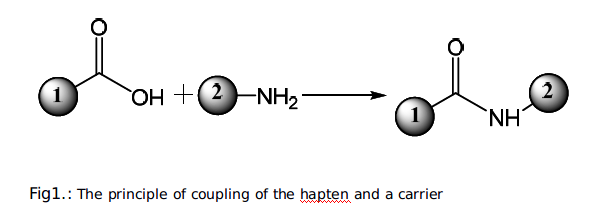Structure modification of small molecule haptens
To be prepared the antibodies against small molecules, the structure of small molecules is important, and it is commonly to have a certain complexity and rigidity, including benzene rings, heterocyclic groups or branched structures, otherwise, it would be difficult to produce antibodies with good titers.
Some haptens have a reactive group, such as -COOH, -NH2, -OH, etc., and these haptens could be directly conjugated to a carrier protein, and then to be a totally artificial antigen, please see the the principle of coupling in Fig1.. However, the haptens should be re-designed and modified if there are no reactive groups which could be covalently conjugated to a carrier, or though the haptens have active groups but these groups are very important to maintain the immunogenic properties and structure of the haptens, or after haptens are conjugated to a carrier protein, the feature structure of haptens will be influenced by local chemical environment of carrier or steric hindrance, and then the body’s immune response will be affected.

There are multiple factors which can influence the activity of the small molecules, such as, the original molecular structure, connecting arm, active groups, space conformation, so there would be some technical problems in the modification of haptens, and below are the aspects:
1. How to choose the antigen binding site? The immune response could bedifferent when the modification of haptens happened at different binding site.
2. How to choose the connecting arm and its length? It is need to notice that there should not be immune response of connecting arms or the reactive groups.
3. The assessment of connection effect of haptens and carrier proteins, such as the coupling ratio.
4. The assessment of the concentration of artificial antigen and its immunogenicity.
5. The specificity and affinity of the antibodies.
Based on the large of references, considering the specific functional group and structure character of target small molecule, Cloud -clone corp. has developed a mature modification scheme to get the totally artificial antigens, and then to prepare the monoclonal antibody and polyclonal antibody.
Now we make a brief introduction of the common method of structure modification of small molecules.
1. Hydroxy could be modified to carboxyl with succinic anhydride method.
2. Carbonyl could be modified to hydroxy with carboxymethyl hydroxylamine method or PABA method.
3. Phenolic hydroxyl could be modified to carboxyl with chloroacetic acid sodium method or diazotization method.
4. Amine compounds could be modified to amino compounds with Mannish method.
We will introduce the carrier proteins and the coupling methods in the next topic.
For more information, please visit: http://www.cloud-clone.us/.
